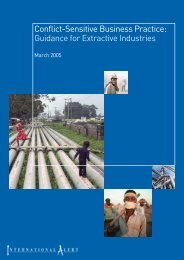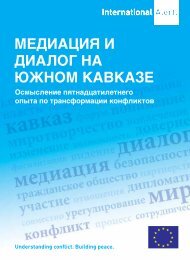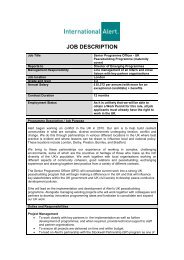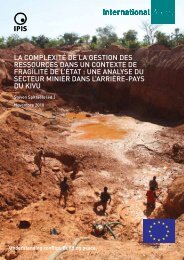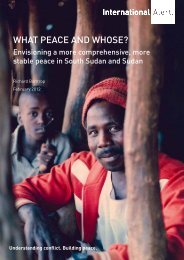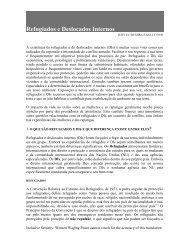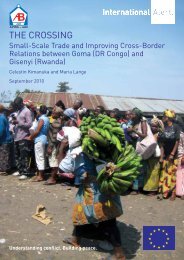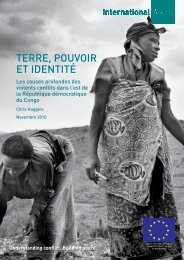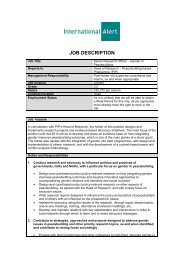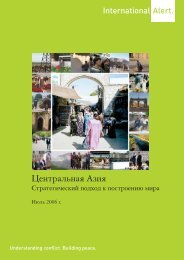The complexiTy of resource governance in a conTexT of sTaTe ... - Ipis
The complexiTy of resource governance in a conTexT of sTaTe ... - Ipis
The complexiTy of resource governance in a conTexT of sTaTe ... - Ipis
You also want an ePaper? Increase the reach of your titles
YUMPU automatically turns print PDFs into web optimized ePapers that Google loves.
46 International Alert<br />
In the m<strong>in</strong>es surveyed <strong>in</strong> Mambasa territory, the total artisanal population for 112 m<strong>in</strong>es for<br />
which <strong>in</strong>formation was available is estimated at 4,622 persons, 167 a small number for such a<br />
large number <strong>of</strong> sites. Local stakeholders po<strong>in</strong>ted out that the most productive sites are located <strong>in</strong><br />
Bakaiko groupement <strong>in</strong> the south <strong>of</strong> the territory, for which no figures are available. <strong>The</strong> largest<br />
site the team was able to visit is Maka, 168 with an estimated 400 artisanal m<strong>in</strong>ers.<br />
In southern Bafwasende territory, accord<strong>in</strong>g to the most important m<strong>in</strong>e operator, Marc Ndjoka<br />
(see below), his 13 sites produce roughly 1 kg <strong>of</strong> gold per week. Production <strong>in</strong> the few other gold<br />
m<strong>in</strong>es surveyed ranges between 11 and 145 grams each week.<br />
Of the 35 m<strong>in</strong>es most closely surveyed <strong>in</strong> Mambasa territory, only one third claimed to produce<br />
more than 10 grams a day. This is a very low figure when compared to the OKIMO sites <strong>in</strong><br />
northeastern Orientale where one artisanal m<strong>in</strong>er produces 1–1.5 grams a day on average. It must<br />
be recalled that the average m<strong>in</strong>e size <strong>in</strong> the Mambasa area is very small.<br />
3.3 General analysis <strong>of</strong> the m<strong>in</strong>eral trade<br />
Unlike the previous two chapters, where the focus is exclusively on economic operators and trade<br />
routes, this section also provides an overview <strong>of</strong> a number <strong>of</strong> other dynamics around the m<strong>in</strong>es,<br />
<strong>in</strong>clud<strong>in</strong>g issues <strong>of</strong> m<strong>in</strong>e <strong>governance</strong>, <strong>in</strong>ternal organisation and micro-level trade.<br />
Ownership and permits<br />
In Orientale prov<strong>in</strong>ce, all artisanal m<strong>in</strong><strong>in</strong>g sites are managed by a so-called AFM (Adm<strong>in</strong>istrateur<br />
de Foyer M<strong>in</strong>ier or m<strong>in</strong><strong>in</strong>g site adm<strong>in</strong>istrator). <strong>The</strong> role <strong>of</strong> AFM pre-dates the 2002 M<strong>in</strong><strong>in</strong>g<br />
Code, <strong>in</strong> which it is not <strong>in</strong>cluded. 169 <strong>The</strong> AFM submits a déclaration d’ouverture (d’un chantier<br />
d’exploitation artisanale) for a specific area to the Prov<strong>in</strong>cial Division <strong>of</strong> M<strong>in</strong>es, which authorises<br />
him to exploit it by sign<strong>in</strong>g the document. 170 This “declaration <strong>of</strong> open<strong>in</strong>g” is mentioned <strong>in</strong> the<br />
M<strong>in</strong><strong>in</strong>g Code 171 and was later specified <strong>in</strong> the 2003 M<strong>in</strong><strong>in</strong>g Regulations, 172 but there it refers to<br />
the holder <strong>of</strong> an <strong>of</strong>ficial m<strong>in</strong><strong>in</strong>g title, which is issued by the Cadastre M<strong>in</strong>ier (M<strong>in</strong><strong>in</strong>g Registry,<br />
CaMi). CaMi does not recognise these prov<strong>in</strong>cial artisanal-exploitation permits, and does not<br />
consult with the Prov<strong>in</strong>cial Division <strong>of</strong> M<strong>in</strong>es before issu<strong>in</strong>g large-scale m<strong>in</strong><strong>in</strong>g concessions. 173<br />
Generally, permits issued by CaMi therefore relate to areas where artisanal m<strong>in</strong>ers are already<br />
work<strong>in</strong>g, under the direction <strong>of</strong> an AFM possess<strong>in</strong>g a déclaration d’ouverture.<br />
<strong>The</strong> AFM is considered the owner <strong>of</strong> his site(s) and acts as such. He sets rules and imposes taxes<br />
on m<strong>in</strong>ers, suppliers and traders. He has his own – unarmed – security service 174 and “douane”<br />
(“customs”). 175<br />
<strong>The</strong> most important AFM <strong>in</strong> Opienge region (Bafwasende Territory) is Marc Ndjoka Kabasele,<br />
whose company NDJOKAM (Société Ndjoka Agro-M<strong>in</strong>ière) has “owned” most 176 <strong>of</strong> the sites<br />
<strong>in</strong> the region s<strong>in</strong>ce 1983. Despite be<strong>in</strong>g from the area, he faced <strong>in</strong>timidation by Mayi-Mayi<br />
167 Bureau M<strong>in</strong>ier Isolé du District de l’Ituri gives an estimate <strong>of</strong> around 10,000 for 45 foyers m<strong>in</strong>iers ou regroupements m<strong>in</strong>iers <strong>in</strong> its Rapport<br />
annuel exercice 2009, p. 6.<br />
168 Adm<strong>in</strong>istratively, Maka is located <strong>in</strong> Wamba territory, a few kilometers from Mambasa Territory, but the Poste M<strong>in</strong>ier <strong>of</strong> Nia-Nia is <strong>in</strong> charge<br />
<strong>of</strong> its m<strong>in</strong><strong>in</strong>g adm<strong>in</strong>istration. Furthermore, <strong>of</strong>ficials from the Antenne M<strong>in</strong>ière <strong>of</strong> Wamba also frequent the site.<br />
169 See also Orientale prov<strong>in</strong>ce. Division Prov<strong>in</strong>ciale des M<strong>in</strong>es, Rapport annuel 2009, p. 24.<br />
170 Sometimes it is signed – albeit illegally - by the head <strong>of</strong> the local Bureau m<strong>in</strong>ier or Antenne m<strong>in</strong>ière.<br />
171 Article 218.<br />
172 Article 484.<br />
173 Interview, Prov<strong>in</strong>cial Division <strong>of</strong> M<strong>in</strong>es <strong>of</strong>ficials, Kisangani, July 2010. See also Partnership Africa Canada (PAC), Diamonds and Human<br />
Security. Annual Review 2009, p. 12; and R. de Kon<strong>in</strong>g (2009), op. cit. p. 14.<br />
174 Known as “BD” (brigade discipl<strong>in</strong>aire).<br />
175 <strong>The</strong>se employees collect entrance (and, sometimes, exit) fees on the site.<br />
176 Some 22 <strong>in</strong> all, <strong>in</strong> a very wide area <strong>in</strong> the forest around Elonga, east <strong>of</strong> Opienge.





